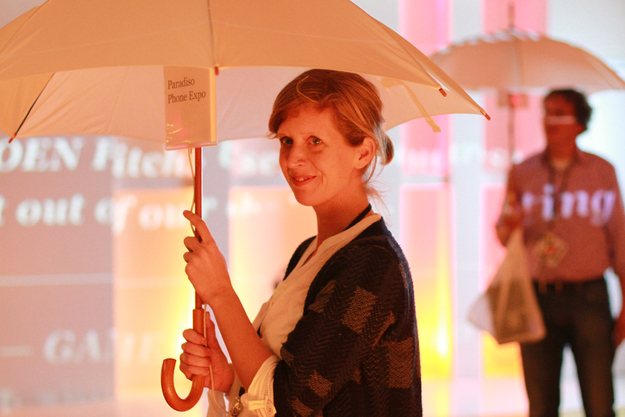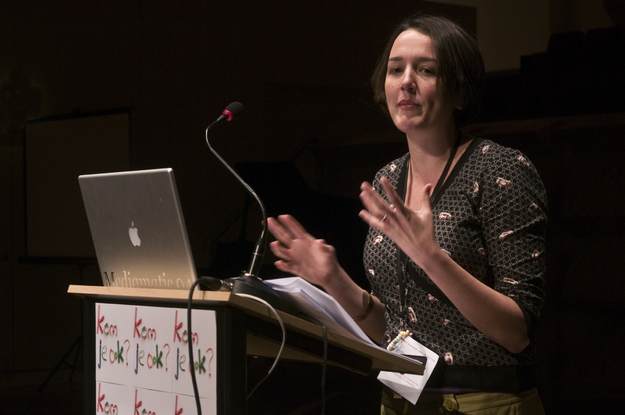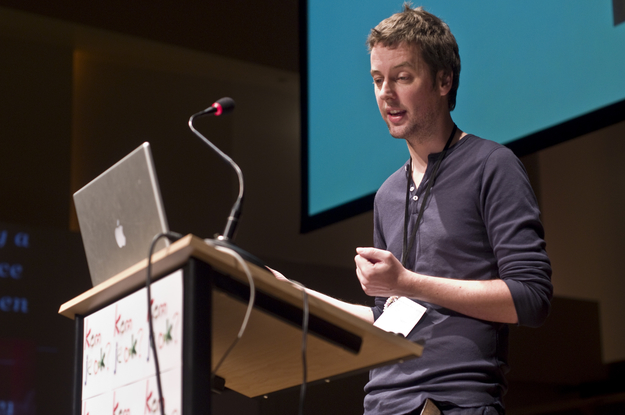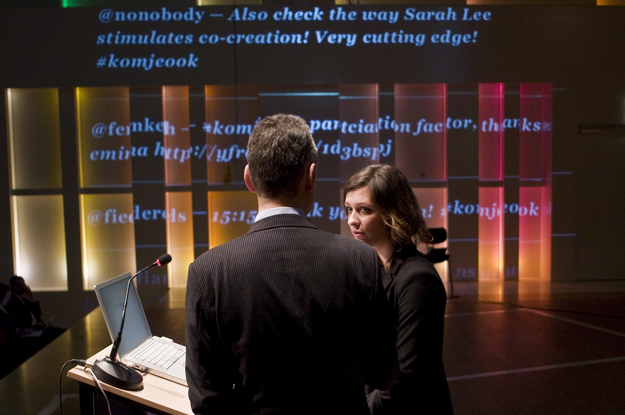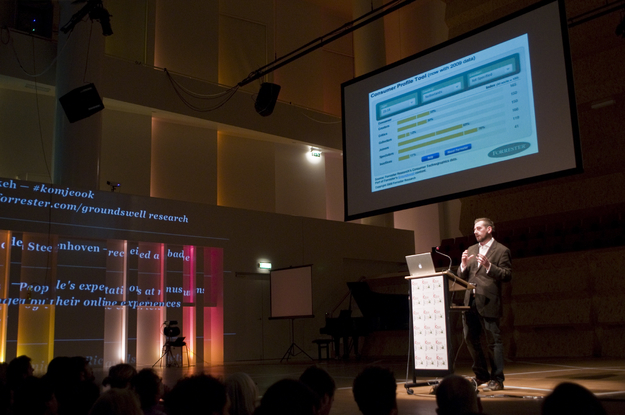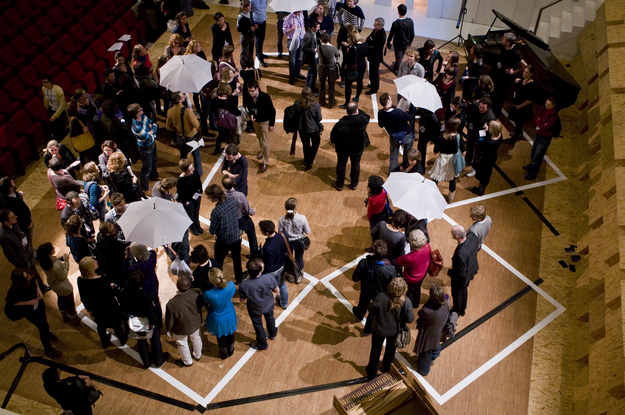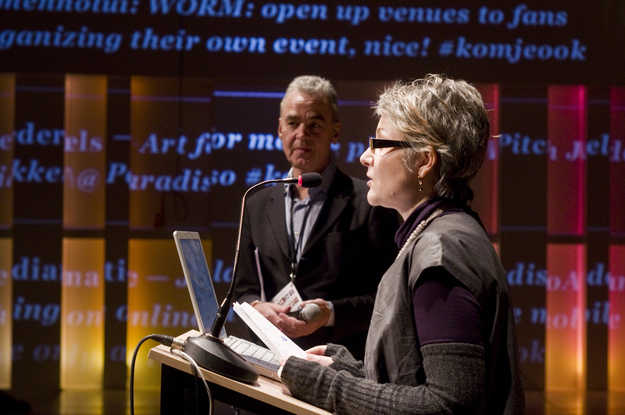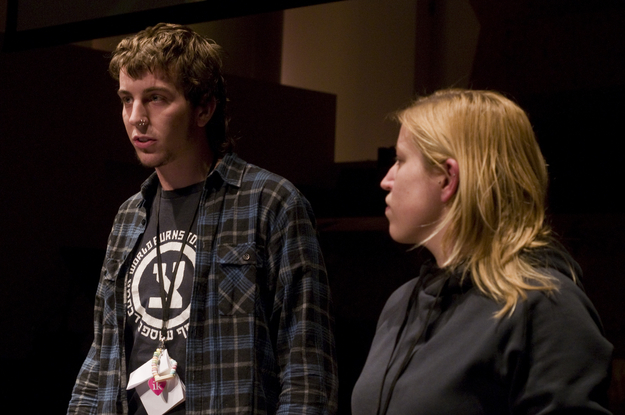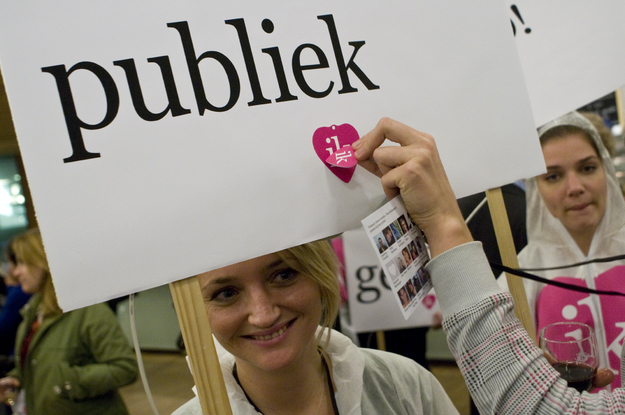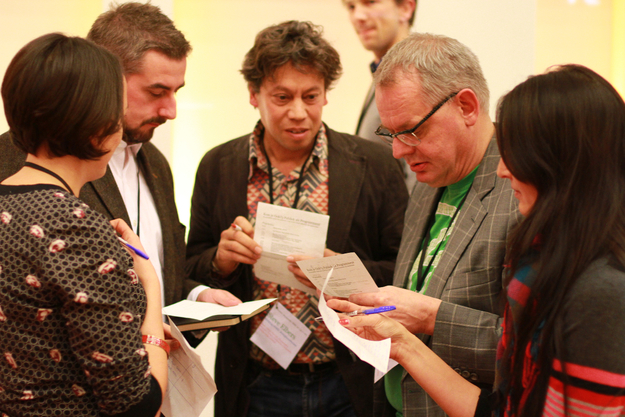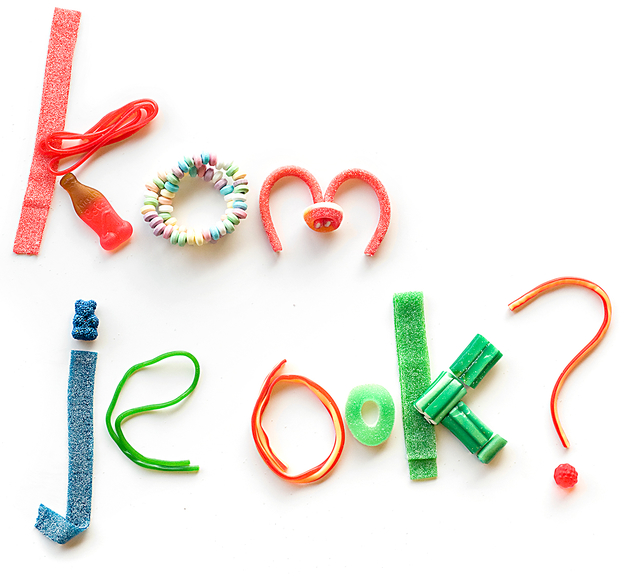Keynote ‘The Audience as Programmer’ by Fiona Romeo
After a word of welcome by chairman of the day Riemer Knoop, the first keynote speaker takes the stage. Fiona Romeo works as head of digital media for the National Maritime Museum and Royal Observatory Greenwich in London. In her talk Fiona shows examples of how cultural organisations can involve their audience as programmers. She distinguishes three levels of involvement in her practice: in exhibitions, events and research.
Exhibitions should encourage people to be playful. Fiona explored this herself while designing the exhibition The Science of Spying, an interactive family exhibition about secret services, surveillance and modern day spying for the Science Museum in London. For every single object in the exhibition the team figured out the social interaction. The audience could take on the role of performers, so that the attention was also directed to the other people in the exhibition space. The last mission in the exhibition was to pass the body scanner unnoticed by taking on positions and movements that will not be recognized as human. People teamed up to create shapes that would not be detected by the scanner.
The second level of audience involvement is to invite people to co-create events. The Royal Observatory started the contest the astronomy photographer of the year on Flickr where people shared their best photos of space. With all these amazingly beautiful pictures the Observatory made an exhibition and set off to create a user generated map of space. The third level of participation is to invite your audience to work on parts of your research. Solar Stormwatch is a research project that uses crowdsourcing to give a realtime space weather forecast on Twitter.
Fiona Romeo urges cultural organisations to start working in new ways. Producing large finished projects, publications and products is time-, cost- and energy intensive and does not guarantee audience attention. Setting up your projects in a new way means thinking about opening up the creation process and making it part of the project. Inviting other people to create content across different platforms enables attention over a much longer period of time. When opening up and inviting audiences to join in, cultural organisations benefit from people that are willing to put in time, and will be surprised by unexpected questions that they would never have asked themselves.
Fiona's presentation on SlideShare
Joost Heijthuisen (Incubate) and Floor Ziegler (Noorderparkkamer)
Fiona Romeo's talk is followed by two short presentations. Joost Heijthuisen from the Incubate Festival shows us the principles behind the social festival model he used for his festival's website. Users of the site are able to create all the content and everything is licensed under Creative Commons. The website is a successful example of what a very open way of working and sharing knowledge can lead to.
Joost's presentation on SlideShare
Floor Ziegler, artistic leader of the of the Noorderparkkamer, explains how she gets artists to establish meaningful relationships with the residents of Amsterdam Noord, where their projects are taking place.
Floor's presentation on Picasaweb.
Emina Sendijarevic on ‘The Online Participation Factor’
After the short break, chairman Riemer Knoop introduces Emina Sendijarevic, an employee at Mediamatic who talks about interaction in online communities. Despite the hype of online communities of the last few years, participation is still low. People don’t contribute to community websites. Emina looks for the ‘participation factor’ and gives some examples of websites that have an active circle of contributors and participants. On Yunomi, a community website for women, contributors can win prizes. But that’s not the most important reason for active participation, thinks Emina. People just want to share their personal story with others, and this website gives them the opportunity. Another example of a flourishing online community is My Starbucks Idea, where members are asked to think about their coffee wishes: ‘You know better than anyone else what you want from Starbucks. So tell us. What’s your Starbucks Idea?’. The website not only stimulates people to discuss coffee, but what they say will also have an effect. So what’s the participation factor? Emina concludes. ‘Letting people freely participate and rewarding them. People want something in return.’
Emina's presentation on SlideShare
In the meantime, the participants in the audience are looking at their i-phones, while tweets are projected on the wall.
Find all the tweets with the hashtag #komjeook here.
Keynote ‘Co-producing the Museum’ by Jim Richardson
The lecture of Jim Richardson, managing director of a consultancy agency working in the arts and a gifted speaker and writer, connects to the subject of Emina. He states that museums have to change because of the changing expectations of the audience. Static information is not enough anymore; museums must respond to the online experiences of cultural consumers by giving the audience the chance to be a participant of the museum, rather than only be a spectator. Jim comes up with four types of cultural consumers and gives examples of existing projects (mostly in the United States) in which the audience plays a leading role. With ‘Tate Tracks’ (2006) the Tate Modern in London lets contemporary musicians write new tracks, inspired by works of art on display at Tate Modern. Visitors of the museum got the first chance to hear the track before it was released. The Metropolitan Museum in New York encouraged visitors to photograph their experience, what resulted in kissing couples before ‘The Kiss’ of Auguste Rodin and visitors imitating the facial expressions of sculptures. ‘There is so much to do!’ Riemer Knoop exclaims at Jim’s appeal, ‘how do you start?’. Jim immediately takes the microphone. ‘Come up with a social media plan or choose an idea from my presentation and work it out in your own way.’
Jim's keynote 'Co-producing the Museum' on his own blog
blogpost on Kom je Ook? at his blog www.museummarketing.co.uk
Travel project and the next Kom je ook?
At 4 pm Willem Velthoven (Mediamatic) presents Mediamatic’s Travel Project (travel.mediamatic.net), explaining how it works and convincing everybody to come to the Amsterdam Biennale 2009.
Fifteen minutes later it’s time for a discussion about the next Kom je ook? in February. A panel of five people, including Willem Velthoven and Martine Posthuma de Boer (Mediamatic), talk with the audience about the possible themes of the meeting –quality, money, technology,- subjects you can vote on after the discussion. There are some people in the audience who have ideas for improving Kom je ook?. ‘These are all great ideas,’ one woman remarks, ‘but we need to reach curators if we want to change anything. And if they don’t come to meetings like Kom je ook?, then you have to go to them.’ ‘Are there any curators in the audience?’ asks Willem. Two people raise their hands. ‘Alright,’ said Willem, ‘next time there are free tickets for curators.’
Here are some of the points that were raised in the discussion about Kom je ook? 4:
- Some institutions working with web 2.0 have a hard time keeping track of new developments. What's the difference between web 2.0 and 3.0, why do institutes have to make the switch and what are the possibilities?
- Th public likes to know more ‘how to's’ for social media. In what way can social media be implemented?
- The public would like to see more experimental examples
- The public would like a presentation of the best Dutch examples
- How can an organisation be stimulated to change so real innovation can take place?
- It would be nice to have a curator who acknowledges the importance of participation as a speaker
- The public would like more information on how to reach the inactive people on the internet
- Kom je ook? should pay more attention to product innovation
DOEN pitches
The pitches are the last part of the afternoon, with five projects that battle to win a DOEN Clinic. Every pitch lasts 2 minutes and is being judged by the audience and a professional jury. Bart Grob (Boerhaave Museum, Leiden) presents the idea for a new educational program inspired by modern computer games; MyStage from Rotterdam wants support for their mediating role between fans, venues and bands; Jeldau Kwikkel (Paradiso, Amsterdam) has the idea of inviting artists to make artworks for mobile phones, to make art interesting for young people. Dima Stefanova’s project (Grannypedia) makes a great impression. She wants to create a space where authentic knowledge is collected about ways of living that are better for the environment. Wim Wouters and Lotte van de Werf present their project (Grin) of stimulating the public to interact with artworks and museums by making use of 3-D. After the audience and the jury have voted, the winners are presented: MyStage and Grannypedia.
Winners Dima Stefanova (‘GrannyPedia’) and Jacco Rijstenbil and Katelyn Brand (‘MyStage’)
Dima Stefanova (Grannypedia): ‘I want to create a database of local knowledge and global heritage of everything that has to do with sustainable living. I am against mass-consumption and eating has the biggest influence on global warming. I already have a network in Bulgary, but I want to enlarge it; for example by working together with Mediamatic’s Travel project.’
Jacco Rijstenbil: ‘MyStage is a mediating platform between bands, fans and venues. Artists register when they are available and fans can put together different bands in venues. We are searching for the ideal combination for a concert that you can organise yourself, because there are a lot of bands that have many fans but are unknown to venues.’
Made possible by
De Mondriaan Stichting, Stichting DOEN, het Nederlands Fonds voor de Podiumkunsten and Deneuve Cultural Projects.
More Kom je Ook Photo's.
List of participants
Report written by Martine Posthuma de Boer and Thomas van Lier
